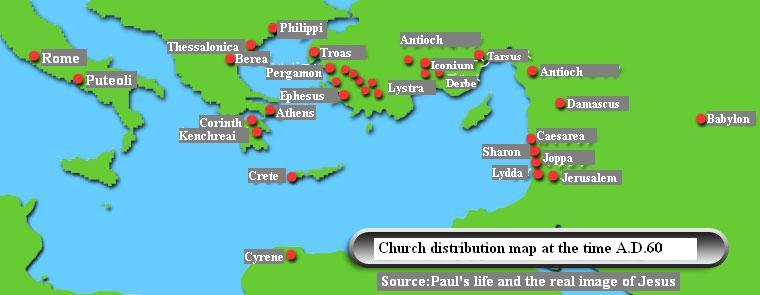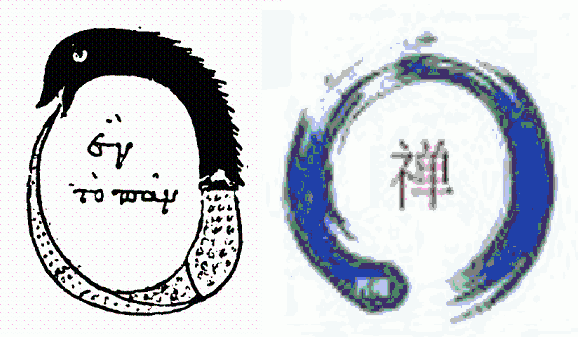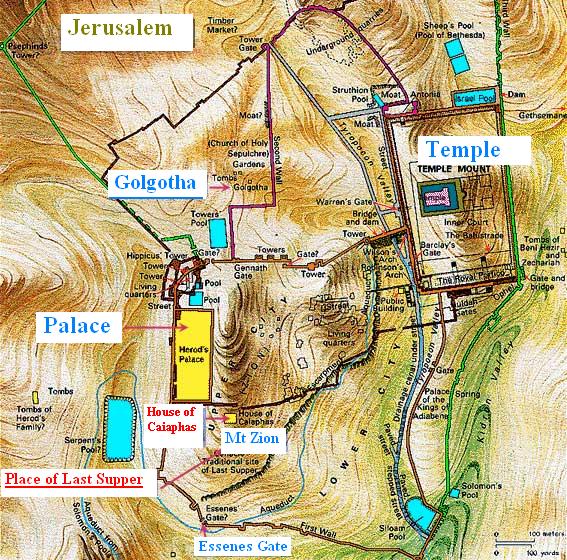|
||||||||
|
|
|
2014-09-26 ArtNo.45355
◆Review:Jesus and Gnosticism--The Origin of Zen Buddhism (2)
Gnostic group such as Thomas, Philip, etc. seems to have been shy away from the idea with strong political color as such "calling back the scattered children of God, to bring them together and revive Israel" from the beginning.
○Jesus' different instructions Jesus initially instructed his disciples to return to Galilee after his crucifixion. (Mark 14:28,16:7, Mat 28:7,10) However, according to the Acts of the Apostles, Jesus gave a new instruction, "Stay in Jerusalem," after the Resurrection. (Acts 1:4) It suggests that a situation, different from the scenario Jesus had drawn before his crucifixion, occurred. At the Last Supper, Jesus told Judas Iscariot his intention to be crucified as initially planned even impossible to return to Galilee after the Crucifixion. Then Judah immediately reported it to the high priest Caiaphas who had lived in next door to the venue of the Last Supper. However, the group of former disciples of John the Baptist, such as Peter, Andrew, James the Greater and John and the group of Gnostics, such as Thomas, Philip and Nathanael seem to have returned to Galilee in accordance with the first instruction of Jesus. (John 21:1, Mat 26:16) ○Establishment of the Primitive Church  The Primitive Church was established at the meeting place of the Essenes adjacent to the residence of the High Priest Caiaphas on the day of Pentecost, barely one and half month after the Crucifixion, and about three thousand new believers including Gentiles were added to the church that day. (Acts 2:1-41) From this, the second instruction of Jesus seems to have been conveyed not only to the followers who had returned to Galilee but also to Gentile churches around the Mediterranean coast. In view of the fact that the primitive church, whose members included representatives of Gentile churches around the Mediterranean coast, was launched in a incredibly short period of time after the Crucifixion, it is considered that much before Jesus told Judas Iscariot his final decision at the Last Supper or even before Jesus started to preach, a detailed schedule had been planned. The schedule might include: 1. the leader of the primitive church will not be Jesus, but James the Less; 2. the primitive church will be launched at the meeting place of the Essenes on the day of Pentecost; etc. And the plan also might have been approved by the High priest, Roman governor and even the royal family of Herod. Otherwise, the inauguration of the Primitive Church participated by representatives of Gentile churches around the Mediterranean coast was impossible to be held in such short period after the Crucifixion. ○Integration of Gnostic, Nazarite and Paul Today, Gnosticism (Jesus), Nazaraitism (James the Less) and Paul's theory of "justification by one's faith" are joining together in the Christianity. While Gnostics made its doctrine clear by denying God of the Old Testament, the authors of the Synoptic Gospels, who seems to have not understood the theory of Gnosticism, tried to rebuild the teachings of Jesus based on the doctrine of the Old Testament. Meanwhile Paul denied the law of the Old Testament, that forms the foundation of Judaism, in order to spread Christianity into the non-Jewish community. From this, we can see that the Primitive Church was a congeries of completely different religious groups. And what made it possible appears to have been the capacious mind of James the Less. In addition, the author of the Gospel of John was committed to fuse theories of these three preceptors, Jesus, James the Less and Paul. ○James the Less and Paul Though James the Less performed all the practices enjoined by that rule of life with rigorous exactness and preached "practice and faith are one", he seems to have not forced his beliefs on others. The contents of the famous Sermon on the Mount seems to be slightly different from powerful personality of Jesus who completed the ruthless plan to be crucified as the Lamb of God, but to be rather perfect for the personality of James the Less who protected the Primitive Church all the harder when the church faced tribulation and persecution. However conflict within the Jerusalem Church intensified after the joining of Paul who never accepted anything different from his beliefs. Meanwhile, the interests of both, James the Less and Paul, appear to have been much each other in respect of weakening (for James) or eliminating (for Paul) the influence of Gnostics to the Primitive Church. ○Gnosticism and the Baptist On the other hand, Gnostic group such as Thomas, Philip, etc. seems to have been shy away from the idea with strong political color such as "calling back the scattered children of God, to bring them together and to revive Israel" from the beginning. They regarded themselves as children of light, or as equal with Jesus. In this regard, they were different from the group of former disciples of John the Baptist such as Peter, James the Great, John, etc. who were homage to Jesus. When the Primitive Church, led by James the Less, was established, they seem to have been committed to missionary work to spread the Gnosticism, the origin of the thought of Jesus, to Samaria and other local regions and overseas. (Acts 8:5) However after the first generation of Gnostics, who had directly known Jesus, passed away, the second generation of Gnostics seem to have tried to rebuild their Gnostic Salvation Myth modeling the Gospel of John and the Revelation. ○The Origin of Zen Buddhism In the Gnostic interpretation, the serpent, who seduced Adam and Eve to take and eat the fruits from the Tree of the knowledge of good and evil (Gnosis Cain) growing in the center of Eden, is described as the type of Jesus Christ, who told humankind the entity of God is The Holy Spirit (The Word). Jesus intended to transfer to us God itself or The Holy Spirit, which could not be expressed in words and letters, in other words, he wanted to baptize us with The Holy Spirit. Not only the Gospel of John and the Synoptic Gospels but also the Pauline epistles mention that Jesus baptized with the Holy Spirit. However, interestingly, though both the Synoptic Gospels and the Gospel of John introduce the matter through the testimonies of John the Baptist in the very early part of each book of the Gospels, Paul little mentions John the Baptist in his letters. The baptism of The Holy Spirit, which had been transmitted to India by one of the Twelve, Thomas, who is honored as the twin of Jesus (Both Didymus and Thomas mean twin in Greek and in Aramaic respectively.), was brought into the tradition of aphoristic teaching of Zen Buddhism and then sublimated into riddle-like koans. ○Uroboros and Circular Figure of Zen Buddhism  Uroboros, an image depicting a serpent eating its own tail, is one of the typical symbol of Gnosticism as symbolic expressions of a thought seeing the beginning and the end as one. The iconography is depicted in the Greek magical papyrus and in a circle made by the serpent's body is written "all things are one" in Greek. This concept, which is expressed clearly in the words "In the beginning was the Word, and the Word was with God, and the Word was God. He (Jesus) was with God in the beginning. (John 1:1-2)" at the beginning of the Gospel of John and in the passage "I am the Alpha and the Omega, the First and the Last, the Beginning and the End" in Revelation of John (Revelation 22:13), has been succeeded to by Zen Buddhism. Jianzhi Sengcan chanshi (?-606), who is known as the Third Chinese Patriarch of Zen Buddhism after Bodhidharma, preaches in his book "Xinxin Ming (Faith-Mind Inscription)", saying, "The best way is circular like great vacuity, with nothing lacking, nothing in excess." Thereafter circular figures have been often used by Zen priests, especially GuiYang School's priests in their preaching. The one who first drew circular figures is said to be NanYang HuiZhong chanshi, a disciple of the Sixth Patriarch HuiNeng DaJian chanshi. [Reference] ○Jesus' different instructions Mark 14:28 But after I have risen, I will go ahead of you into Galilee." Mark 16:7 But go, tell his disciples and Peter, 'He is going ahead of you into Galilee. There you will see him, just as he told you.' " Mat 28:7 Then go quickly and tell his disciples: 'He has risen from the dead and is going ahead of you into Galilee. There you will see him.' Now I have told you. Mat 28:10 Then Jesus said to them, Do not be afraid. Go and tell my brothers to go to Galilee; there they will see me. Acts 1:4-5 On one occasion, while he was eating with them, he gave them this command: "Do not leave Jerusalem, but wait for the gift my Father promised, which you have heard me speak about. For John baptized with water, but in a few days you will be baptized with the Holy Spirit." ○Place of Last Supper The meeting place of the Essenes appears to have been used for the venue of the Last Supper and the Primitive Church's Inauguration.(Lower Left)  Please check the contents that have been updated in this article on"The Origin of Christianity", an e-book, which is being updated from time to time. Free download of "The Origin of Christianity"Your CommentsSEAnewsFacebookSEAnewsGoogle |
|
[Your Comments / Unsubscribe]/[您的意见/退订]/[ご意見/配信停止]
Please do not directly reply to the e-mail address which is used for delivering the newsletter. 请别用递送新闻的邮件地址而直接回信。 メールをお届けした送信専用アドレスには返信しないで下さい。 |